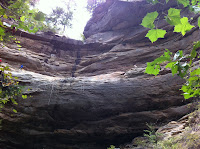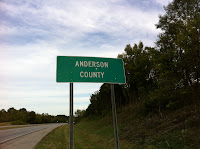WOLFE COUNTY BACKGROUND
Wolfe County was formed in 1860 from parts of Breathitt, Morgan, Owsley and Powell Counties. It was the 110th county created in the Commonwealth. It was named for Nathaniel Wolfe, a member of the Kentucky Legislature. The City of Campton serves as the county seat.
The original courthouse was a log structure, that burned in 1884. The second courthouse was completed in 1885 but burnt in 1913. The 3rd and current courthouse was completed in 1917 and is a beaux-art influenced design.
Unfortunately, after searching for quite some time, I have found very little information on the history of Wolfe County. If you have any information or resource the could help us write a better background, please share them with us.
OUR VISIT
 Like I mentioned earlier, we had no intention of stopping in Wolfe County on this trip. But, as we were heading down Highway 11, we came across Torrent Falls Resort. As we drove by it, all of us in unison said, "What was that?". So we turned around to check it out.
Like I mentioned earlier, we had no intention of stopping in Wolfe County on this trip. But, as we were heading down Highway 11, we came across Torrent Falls Resort. As we drove by it, all of us in unison said, "What was that?". So we turned around to check it out. It turns out it is a rock climbing / rappelling adventure park. We were met by a nice young lady that explained all of the programs and trails that were offered. Knowing we were on a schedule, we picked up all the information we could and have added it to our "Gotta go Back" list. She did allow us to walk around and see the property and get a closer look at some of the climbing trails.
I know it doesn't seem like much, but we decided this was enough to qualify as our visit to Wolfe County. We have talked about this before, we are just going to have to sacrifice and limit our visits in some counties. So, we headed on to Lee County.
But the story doesn't stop there. When we left Beattyville, we came back up Highway 11 towards the Mountain Parkway. Right as we were about to cross the county line from Wolfe County back into Powell County, one of the boys said, check out that waterfall. I about wrecked the car trying to get it stopped and turned around. It turns out it wasn't really a water fall, but the runoff for Mill Creek Lake. It is a great roadside park. We got out and the boys and I walked up and down the spillway and even skipped a rock or two.
 Again, it seems like we really shorted Wolfe County, but we truly enjoyed our time there. I wish we didn't have to make sacrifices, but if we want to finish this project, we really have no choice.
Again, it seems like we really shorted Wolfe County, but we truly enjoyed our time there. I wish we didn't have to make sacrifices, but if we want to finish this project, we really have no choice.The good news is, with the visit to Wolfe County we are 20% of our way through the 120 in 12. Before we write about Lee County, I will be posting a video of all the pictures we've taken on the second set of 12 and a posting a little bit of reflection on where we've been and where we're headed.




















































